- Geomagnetism is a relatively new field of study and it has increased our knowledge related to geological processes and the earth’s interior.
- This field of study in geomorphology is credited to William Gilbert.
- Geomagnetism is the study of the dynamics of the Earth’s magnetic field, which is produced in the outer core.
- The Earth’s magnetic field is predominantly a geo-axial dipole, with north and south magnetic poles located near the geographic poles.
- Earth’s magnetic field is known to have wandered and flipped in the geologic past. This wandering has generally been quite slow, around 9 km a year, allowing scientists to easily keep track of its position. But since the turn of the century, this speed has increased to 50 km a year.
- The earth act as a dipole magnet where the geomagnetic south pole is near the earth’s geographic north and vice versa.
- The magnetosphere (zone in which we can feel magnetic effect) extends to about 60,000 km over earth’s surface.
- Geomagnetism is one of the fundamental interactions in universe which provides the study of magnetic fields near the earth’s surface.
- Earth’s magnetic field extends up to 3200 km which can dispel the solar wind and save earth from disaster.
- It protects us from solar flares and plays an important role in blocking the harmful gamma rays from the sun.
- Some movements of earth’s geological past are known to have witnessed the disappearance of magnetic field. These phases also coincide with some of major extinction on earth.
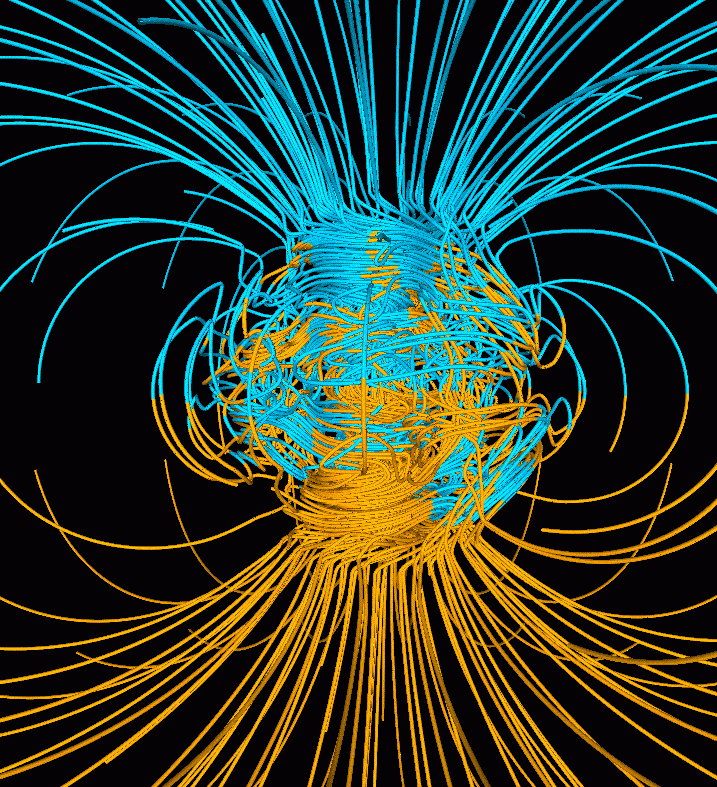
Magnetic Poles & Geomagnetic Poles
- A magnet’s North pole is thought of as the pole that is attracted by the Earth’s North Magnetic Pole when the magnet is suspended so it can turn freely.
- Since opposite poles attract, the North Magnetic Pole of the Earth is the south pole of its magnetic field.
- Magnetic dipole field (simple north-south field like that of a simple bar magnet) is usually aligned fairly closely with the Earth’s rotation axis; in other words, the magnetic poles are usually fairly close to the geographic poles (earth’s axis passes through these poles), which is why a compass works.
- However, the dipole part of the field reverses after a few thousand years causing the locations of the north and south magnetic poles to switch.
- Earth’s magnetic North Pole is quickly moving from the Canadian Arctic towards Russia.
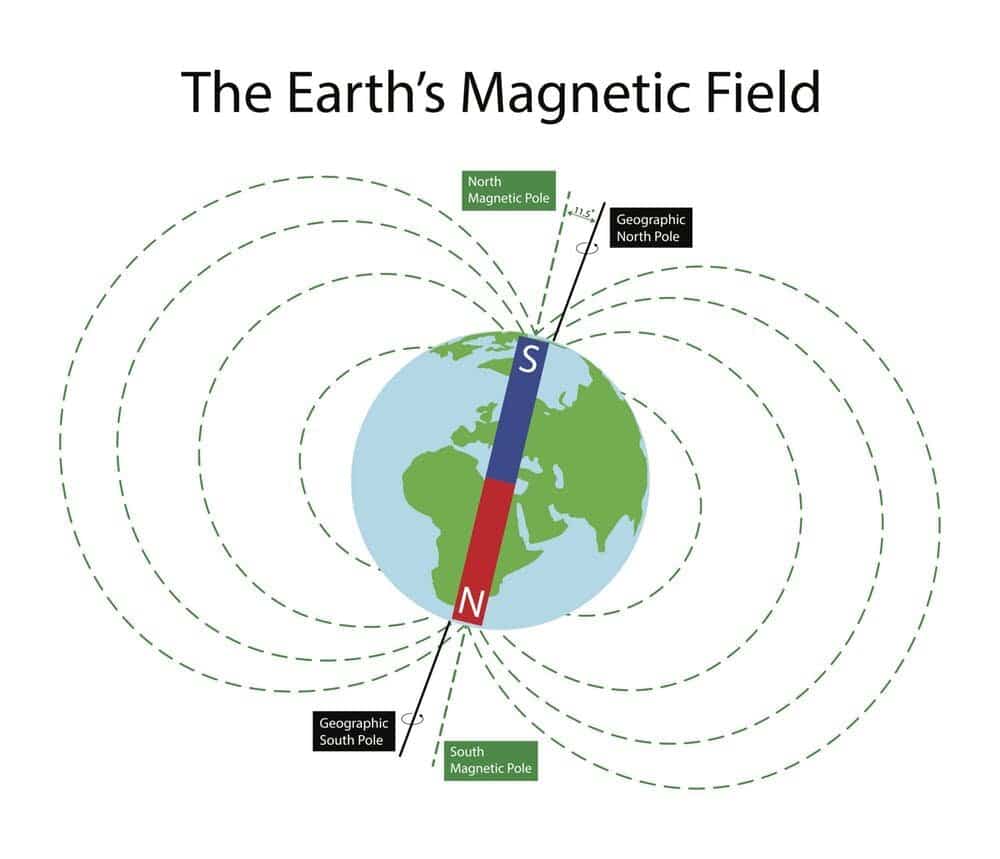
- The Geomagnetic poles (dipole poles) are the intersections of the Earth’s surface and the axis of a bar magnet hypothetically placed at the centre the Earth.
- There is such a pole in each hemisphere, and the poles are called as “the geomagnetic north pole” and “the geomagnetic south pole”, respectively.
- Approximately, geomagnetic dipole is currently tilted at an angle of about 11 degrees to Earth’s rotational axis.
- On the other hand, the magnetic poles (the magnetic north pole and the magnetic south pole) are the points at which magnetic needles become vertical.
- The difference in the position of magnetic poles and geomagnetic poles is due to the uneven and complex distribution of the earth’s magnetic field.
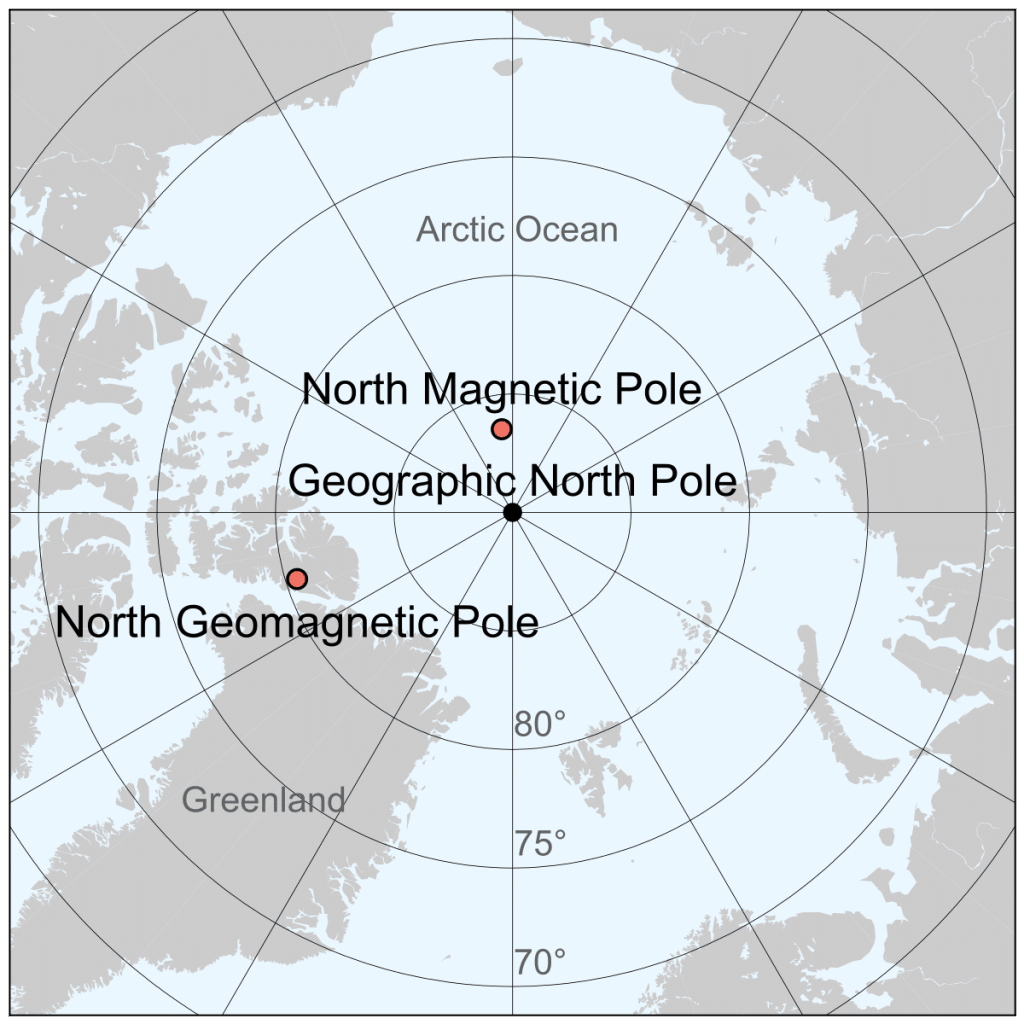
- The geomagnetic poles are antipodal points where the axis of a best-fitting dipole intersects the surface of Earth. This theoretical dipole is equivalent to a powerful bar magnet at the center of Earth and comes closer than any other model to describing the magnetic field observed at Earth’s surface.
- In contrast, the magnetic poles of the actual Earth are not antipodal; that is, the line on which they lie does not pass through Earth’s center.
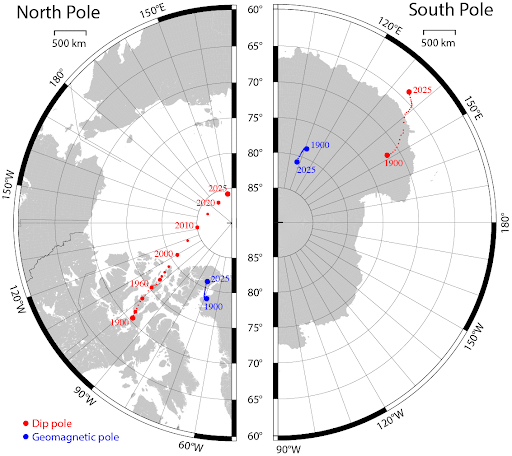
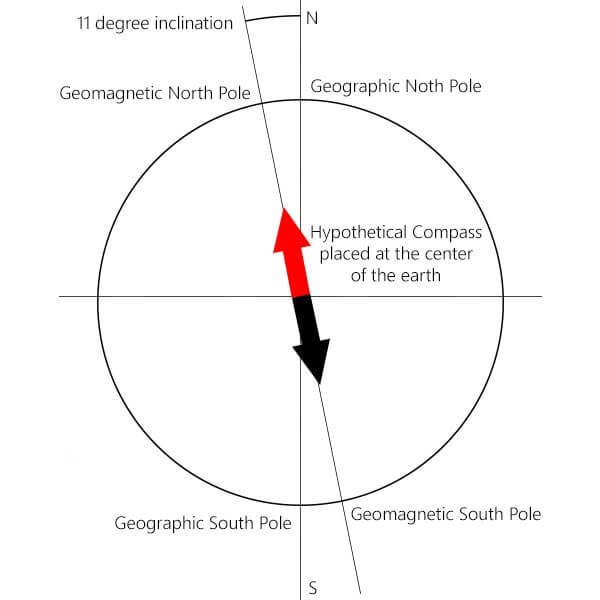
Geomagnetic Reversal
- A geomagnetic reversal or a reversal in earth’s magnetic field is a change in a planet’s magnetic field such that the positions of magnetic north and magnetic south are interchanged.
- Based on palaeomagnetism (magnetism in rocks that was induced by the earth’s magnetic field at the time of their formation), it is observed that over the last 20 million years, magnetic north and south have flipped roughly every 200,000 to 300,000 years.
- The reversal is not literally ‘periodic’ as it is on the sun, whose magnetic field reverses every 11 years.
- The time between magnetic reversals on the Earth is sometimes as short as 10,000 years and sometimes as long as 25 million years, and the time it takes to reverse could be about a few hundred or a few thousand years.
- The magnetic poles emerge at odd latitudes throughout the process of the reversal.
- The Earth’s field has alternated between periods of normal polarity, in which the predominant direction of the field was the same as the present direction, and reverse polarity, in which it was the opposite.
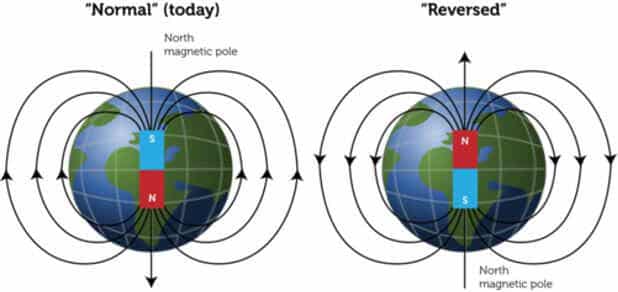
- The North and South Magnetic Poles wander (Polar Shift Theory) due to changes in Earth’s magnetic field.
- The North Magnetic Pole (86֯ N, 172֯ W) lie to the north of Ellesmere Island in northern Canada and is rapidly drifting towards Siberia.
- The location of the South Magnetic Pole is currently off the coast of Antarctica and even outside the Antarctic Circle.
- Scientists suggest that the north magnetic pole migrates about 10 kilometres per year.
- Lately, the speed has accelerated to about 50 kilometres per year and could reach Siberia in a few decades.
- Since the Earth’s magnetic field is not exactly symmetrical, the North and South Magnetic Poles are not antipodal (a straight line drawn from one to the other does not pass through the centre of the Earth).
- The Earth’s North and South Magnetic Poles are also known as Magnetic Dip Poles because of the vertical “dip” of the magnetic field lines at those points.
- That is, if a magnetic compass needle is suspended freely at the magnetic poles then it will point straight down at the north magnetic pole (south pole of earth’s magnetic field) and straight up at the south magnetic pole (north pole of earth’s magnetic field).
Sunspot theory
- Sun by itself is a huge magnet and when it is in waxing period of magnetism and the sunspot activity is high, the solar wing can breach magnetic shield of earth and enter earth’s sphere conditional to the fact that earth’s magnetism is in waning period. Earth may acquire magnetism according to magnetic polarity of sun.
- Meteoric hit or hit by a comet can reverse the polarity because due to collision, magnetism is lost and when magnetism is re-organised magnetic poles can reverse it.

Magnetic Declination
- It is also called horizontal component. It is the angle on the horizontal plane between magnetic North and geographic (true) North.
- By convention the declination is positive when magnetic north is east of true north and negative when it is to the west.
- In present perspective magnetic field magnetic declination reveals north magnetic pole to be slightly west of the geographical North Pole and thus magnetic South Pole slightly east of geographical South Pole.
- The molten mobile iron rich core which spins like dynamo flows and causes gradual westward drift of geomagnetic field, resulting in the changing magnetic declination in entire geological past. Declination is measured with magnetic compass.
Magnetic Inclination/Dip Angle/Magnetic Dip
- This component of geomagnetism is identified to be the vertical component. It is defined to be angular inclination between freely suspended magnetic needle and the horizontal plane of earth’s surface.
- Magnetic dip results from the tendency of a magnet to align itself with the line of force. With increase in latitude the dip angle increases making it 90 degree at magnetic pole and 0 degree at magnetic equator. Inclination is measured with dip needle.
- Magnetic Equator: the locus of points having zero dip is called magnetic equator.
Theories about origin of earth’s magnetism
- Gilbert Theory:
- Earth’s magnetism was first discovered by Sir Gilbert in 1600s. According to Gilbert, magnetism is because of an embedded bar magnet in the interior of earth.
- This is however incorrect because it is difficult to explain how the bar magnet magnetism can sustain itself in high temperature and molten rocks of interiors.
- This theory couldn’t explain the periodic reversal of earth’s magnetic polarity without assuming the rotation of magnet itself which improbable.
- Rock magnetism
- Earth’s magnetism may be because of rock magnetism. Rock magnetism is a fact but it is not response for earth’s geomagnetism because randomly created magnetic rocks can’t explain the specific orientation of earth’s magnetic field.
- The high temperature of interior should have destroyed the earth’s magnetism because no magnetism can maintain itself in very high temperature and in molten fluid state.
- Dynamo theory
- In 1939, Walter Alsec gave Dynamo theory. According to this theory magnetism may be the consequence of particular structure of earth’s core.
- The core consists of iron rich solid inner core which is magnetic and outer core which is hot fluid in near plasma state with full movement of free electrons.
- Because of the earth’s rotation the outer core with its free electrons also rotates about the inner core producing dielectricity. This arrangement is called a typical solenoid.
- The solenoid creates a magnetic field which in turn induces a strong electric field which again strengthens the magnetic field. This mechanism referred to as self exiting dynamo.
- This theory though most acceptable one is unable to explain fluctuation in magnetic field and reversal of polarity. Even though earth’s rotation has been very smooth and consistent throughout its geological history earth’s spin never reversed.

one of the best notes for geography optional. It is helping me a lot
Great work and thank you…plz complete the Geo optional ASAP…THANK YOU
Yeah Sure
For the first time getting this complete geography optional materials in a sequenced series that too free of cost. Thank you very much. Really appreciable.
Keep reading and Happy learning.
Thanx a lot lotus arise team
Thanks for providing to the point content for my Geography Optional…..
Thanks Again Lotusarise….❤️❤️❤️
nice content for me
I like your all notes.
I appreciate your hard work.
Thanks you so much